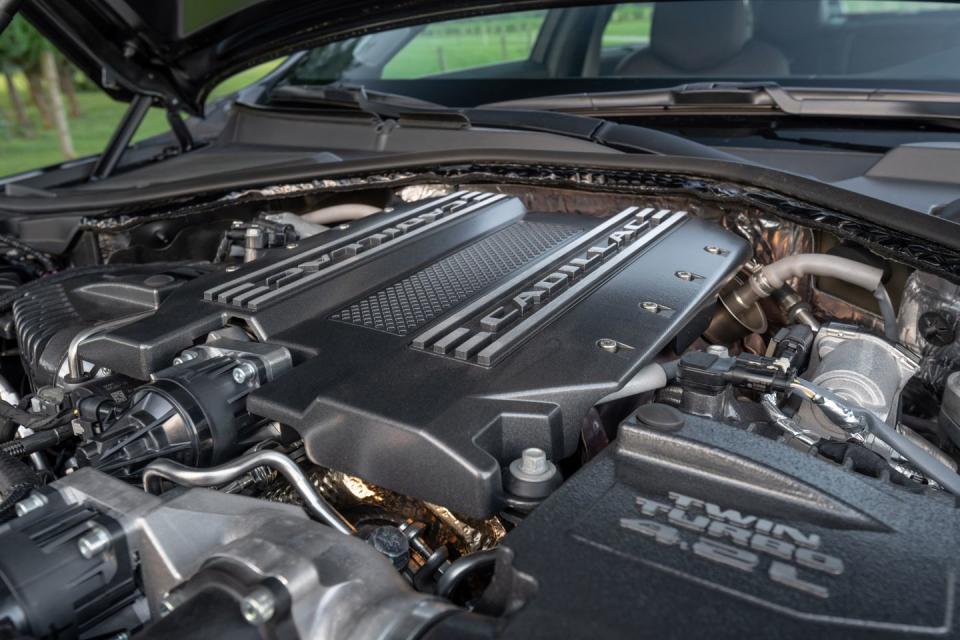A 550-HP V-8 Probably Can’t Save the 2020 Cadillac CT6-V

Officially, the Cadillac CT6-V's fate is undecided. At the same time, General Motors has no plans to build the CT6 after the Detroit-Hamtramck assembly plant ends production in January 2020. That leads us to conclude—unofficially—that this 550-hp sports sedan is a dead man sprinting.
That's a damn shame because Cadillac's $92,790 CT6-V is the only flagship sedan to cut a corner with any sharpness, and its twin-turbo V-8 is the closest the brand has come to giving this chassis the engine it deserves.
The Blackwing V-8
This is not your father's small-block—or his Northstar, for that matter. Known as Blackwing, the all-new engine brings GM into the 21st century by nestling two twin-scroll turbochargers in its valley and spinning four camshafts over its cylinder heads.

It huffs up to 20.0 psi of boost, shoots fuel directly into the cylinders, and channels as much as 640 pound-feet of torque to the transmission through forged connecting rods and a forged crankshaft.
The Blackwing replaces the small-block's lopey idle and rock-star shout with dignified high-end polish. The Caddy's 4.2-liter V-8 revs smoothly and with a deep but domesticated growl. (A tamer Blackwing makes 500 horses and 574 pound-feet of torque in the CT6 Platinum.)

The only impoliteness appears when the engine runs on just four cylinders, which can excite some occasional bad vibes as the throttle is initially opened, creating shudders when the remaining four cylinders return to work.
Performance Expectations
Despite a 3.8-second run to 60 mph and a 12.2-second quarter-mile time, the all-wheel-drive CT6-V never feels aggressively quick. The Blackwing makes its peak torque relatively late for a turbocharged engine, at 3400 rpm. Power tops out at 5000 revs, and the limiter shuts down the party at just 6000 rpm.

Combining this narrow power-delivery window with the 10-speed automatic's tight ratios means that the CT6-V doesn't spend much time in any one gear. All that shifting interrupts the drama of the engine gaining speed. A governor caps the pursuit of speed at a very un-V-like 149 mph.
Those keeping score at home have already noted that the Blackwing's redline arrives 500 rpm earlier than that of the mid-engined Corvette's small-block LT2 V-8, which has to contend with the reciprocating mass of a pushrod valvetrain. What gives?
The Germans have been reversing the flow of their V-8 engines for years, sending the intake air into the heads from the engine's flanks and removing it via the center of the V. But hot-V design is a new challenge for GM, and it's a packaging nightmare for any engineer. It appears that the plumbing chokes the Blackwing as it races toward high revs.
What's Next?
Every Blackwing is assembled in the same Bowling Green, Kentucky, plant where the mid-engined 2020 Corvette will be birthed, and we expect the spiciest versions of that car to be powered by overhead-cam engines. But rumors suggest the most powerful Corvette engines will not be based on the Blackwing and will instead use a flat-plane-crank V-8 with turbos mounted on either side of the block. That makes us wonder what will become of the Cadillac engine. It would make a natural fit in the hottest version of the forthcoming CT5, although that car may get a lower-cost small-block V-8.

The surest way to get your hands on a Blackwing then is to act quickly. While there's still time to put your name in with the roughly 600 others who have preordered a Blackwing-powered CT6, there's no telling what fate holds for this sports sedan, or this engine, after January 2020.
You Might Also Like

 Yahoo Nachrichten
Yahoo Nachrichten 
